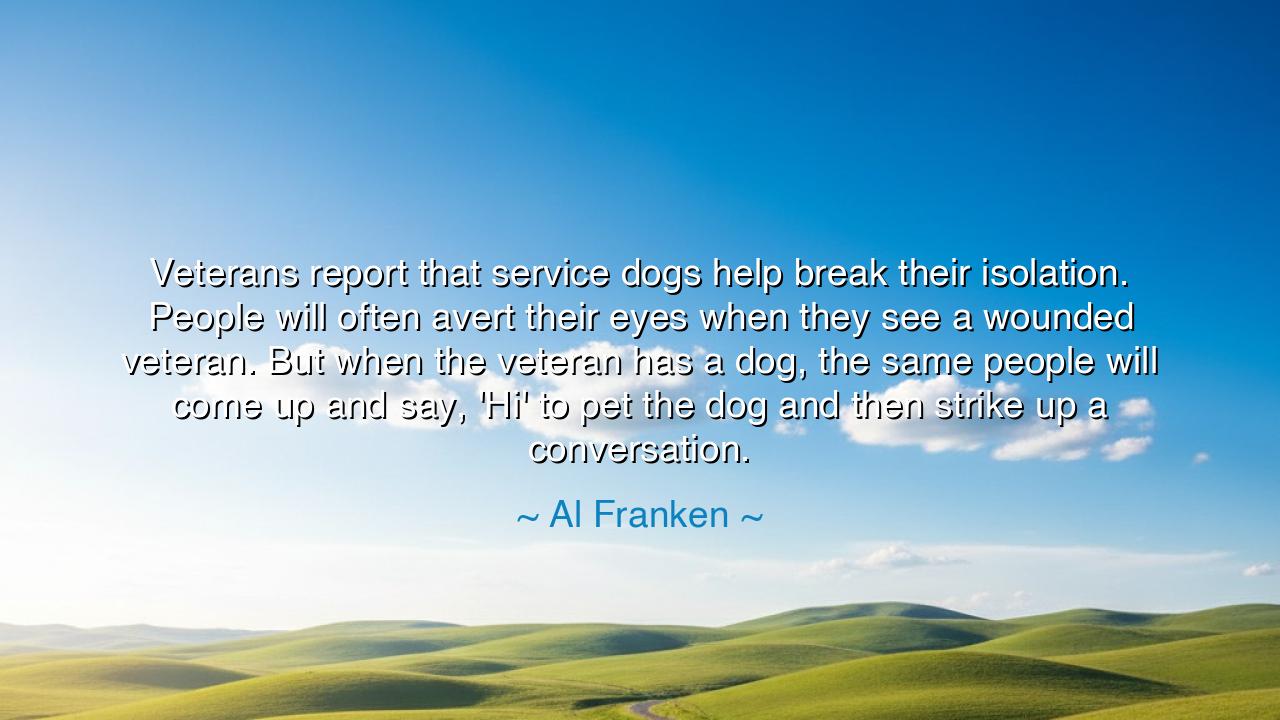
Veterans report that service dogs help break their isolation.
Veterans report that service dogs help break their isolation. People will often avert their eyes when they see a wounded veteran. But when the veteran has a dog, the same people will come up and say, 'Hi' to pet the dog and then strike up a conversation.






The senator and storyteller Al Franken once observed with compassion: “Veterans report that service dogs help break their isolation. People will often avert their eyes when they see a wounded veteran. But when the veteran has a dog, the same people will come up and say, 'Hi' to pet the dog and then strike up a conversation.” These words, though practical in tone, are heavy with meaning. They reveal the loneliness of those who have borne the weight of war, the silent walls society builds around them, and the healing bridge offered by a loyal service dog.
The first truth is in the phrase “help break their isolation.” For the returning soldier often carries more than wounds of the body—he bears the unseen scars of the spirit. The battlefield may be far behind, yet the silence of alienation surrounds him still. Many pass him by, not out of cruelty, but out of discomfort, unsure how to face the visible signs of sacrifice. Thus, the veteran is left unseen even in the midst of crowds, as though cloaked in invisibility. Yet, with a dog by his side, that cloak is torn. The animal, full of innocence and joy, becomes a bridge, opening the way for human hearts to connect again.
Franken reminds us of the bitter paradox: “people will often avert their eyes when they see a wounded veteran.” This aversion is not hatred but fear—fear of pain, fear of confronting the cost of war, fear of seeing in another’s body the price of freedom. The ancients knew this fear well. Warriors returning from battle in Greece or Rome were often both honored and shunned, celebrated in parades yet left alone in the shadows. Human beings struggle to face suffering, preferring to look away rather than to bear witness.
But then comes the miracle: “when the veteran has a dog, the same people will come up and say, ‘Hi.’” The dog dissolves fear. It invites approach where wounds had repelled. What the human heart could not do on its own, the gentle wag of a tail accomplishes. The service dog does more than guide or assist—it heals by reawakening community, restoring conversation, returning the veteran to the fellowship of humanity. In this way, the dog is more than companion; it is mediator, priest, and peacemaker.
History offers us an echo in the story of Antisthenes, the pupil of Socrates, who lived with the Cynics—so named for their likeness to dogs. They believed the dog was a model of honesty and simplicity, stripping away pretension and drawing people back to the essence of life. So too do service dogs today serve as living philosophers, teaching that love and trust are stronger than fear, that even the most wounded deserve companionship, that connection can be born from the simplest gestures.
The meaning of Franken’s words is not only about veterans and dogs but about the human condition. We avert our eyes from pain—whether in the wounded soldier, the sick neighbor, or the lonely stranger. We flee from what reminds us of mortality and suffering. But healing comes when we find bridges—whether a dog, a word, or a gesture—that allow us to meet one another again, not in fear but in fellowship.
The lesson is this: do not avert your eyes. Look with compassion upon those who suffer. Speak to them. Acknowledge them. And when you cannot find the words, let kindness guide you through small acts, as simple as greeting a dog. For in that opening, humanity is restored, and the walls of isolation crumble.
Practical action flows from this wisdom. Support the use of service dogs for veterans and for all who suffer from loneliness and trauma. If you meet a veteran, do not turn away—honor their presence with recognition and respect. And in your own life, be willing to be the bridge for another, just as the service dog is: a presence that turns silence into conversation, distance into connection, and isolation into belonging.
Thus, Franken’s words stand as both observation and commandment: a dog may heal what war has broken, but only if we learn to follow its example. To future generations, let this be remembered: love can cross any divide, and even in the darkest wounds, fellowship can be restored through the simplest acts of kindness.






AAdministratorAdministrator
Welcome, honored guests. Please leave a comment, we will respond soon